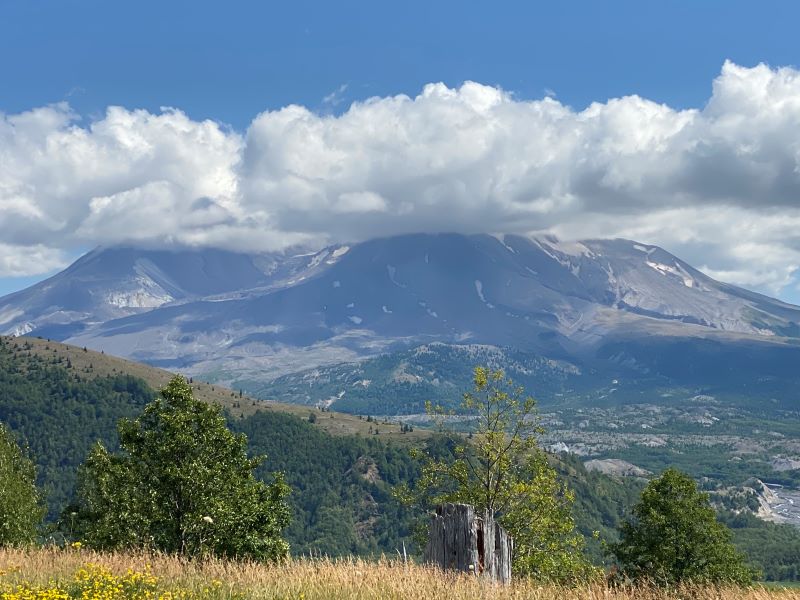Forty-five miles east of the 5 Fwy in Washington lies Mt. St Helens National Park. This is the famous (not so much anymore) volcano that erupted in 1980 after many years of being dormant. I was 17 at the time it erupted and remember the news broadcasting it live and the stories they were telling about how a large portion of the mountain slid down into the valley below. I had always wanted to see it firsthand because it looked like you could not get a grasp on the enormity of the eruption from watching it on a 1980 television. This last week, we finally made it to the park and learned all about that May 18th 1980 day.
About five miles east of the freeway is the first of three visitor centers that were built after the eruption. The first was built by the National Park Service after the area was created into a National Park. The center is quite large and offers several exhibits, movies and displays all explaining how the mountain erupted. Outside you can take in a view of the mountain and take some pictures.
Up the road another 35 miles is another visitors center built by Weyerhaeuser Corporation. This center explains how the clean up of the aftermath was done and goes into detail about how the logging industry works in the area. It is very educational as Lori, and I had a list of questions since we had been driving around the Pacific Northwest and seeing areas of logging. Outside you can see great views of the mountain and valleys below where the eruption remnants are still visible.
The last visitors center is about 5 more miles up the road and this one focuses on the animals and plants in the area. This is the closest to the mountain and you can see up into the mountain when the clouds dissipate.
There is another viewing station still further up the mountain but it was closed due to a landslide that closed the road to it. This one is called the “Johnston Ridge Observatory” and is the closest to the mountain you can get.
We spent the day visiting the centers and then driving around and viewing some of the things they have built since then to keep the ash from moving down the valley. I found the whole experience to be very eye opening. Some things that we learned that we never heard before:
- Anyone near within about 15 miles of the volcano did not hear it when it exploded. There are several stories of people who say they watched it but never heard a thing. This is because the sound went straight up, bounced off the atmosphere and came down miles away.
- The flow from the slide raised the main recreation lake in the area by about 150ft and then made it 50’ deeper.
- The flows from the eruption closed highway 5 because they thought it was going to take out the bridges for the freeway 45 miles away.
- The flows from the eruption raised the bottom of the Columbia River (less draft) and made ships run aground.
All of this was fascinating to look at through the information at the time in the visitors’ centers and then go see the remnants of it firsthand.
As you go from visitor’s center to visitor’s center you notice how big the parking lots are. They are huge and built to hold a great many cars and RV’s but today they are barely used. You could picture it in your mind what it must have been like back then when these centers opened, and people were curious about the only volcano eruption in the US in the history of the states. In fact, we learned that during the days just before the eruption the biggest problem they were having was keeping tourists away from the area. They had even let some homeowners back into the “danger zone” to get some personal items the day before the mountain erupted. They even had a schedule to let people in again on the day it erupted.
It seems to us that the story of Mt. St Helens may be losing some its significance to today’s generation. This is evident by the empty parking lots at the visitors’ centers on the mountain and the lack of traffic on the road up the mountain. I strongly suggest anyone visit the park and go through the visitors centers and the park itself. You will come away in sheer awe of what happened and how the eruptions aftermath is still being dealt with today and will be for many years.
Next stop – Cascade Locks – OR.
Share this post: on Twitter on Facebook
